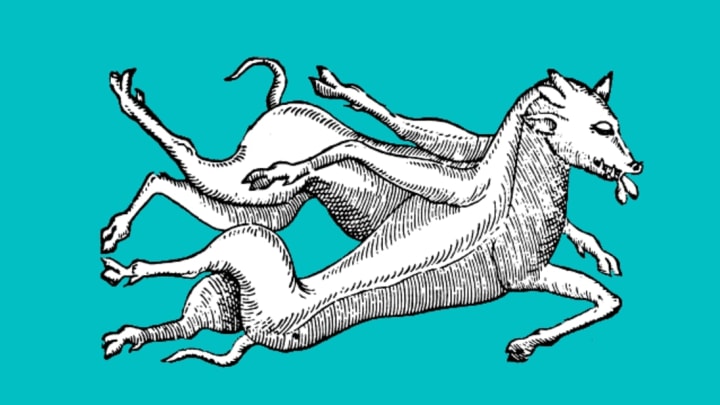Ambrose Pare was a medieval doctor who served as a battlefield surgeon for kings Henry II, Francis II, Charles IX, and Henry III and made great advances in pathology and surgical techniques. (He's the one who convinced people to stop pouring boiling oil in open wounds!) In addition to his many advances, he also had a lot of ideas about how monsters and monstrosities were created. Besides “God’s will” and “evil,” here are 10 ways Pare believed that monsters like man-goats and brain scorpions were created, from his book On Monsters and Marvels.
1. Menstrual Blood
If your baby is born with the head of a parrot, you probably only have yourself—and your menstrual blood—to blame. Pare warned that women “sullied by menstrual blood will conceive monsters.” Also, if your kid is sick a lot, it’s probably because your baby touched your dirty period. Pare wrote, “women who will have conceived during her period will engender those inclined to leprosy, scurvy, gout, scrofula, and more …”
2. Too Much Sperm
Bad news, men: Pare thought that men with “too great an abundance of matter” could produce a baby with “two heads, four arms, four legs, six digits on the hands and feet, or other things.” He used a woman who gave birth to a child with “five horns approximating those of a ram” on its head as an example.
3. Imaginative Faculty
Pare wrote about a woman with two heads who went begging from door to door but was cast out of the area where she lived because doctors believed that if a pregnant woman saw her, she “could spoil the fruit of the pregnant women by the apprehension and ideas which might remain in their imaginative faculty.”
4. Crossing Your Legs
Pare believed that if your womb was too narrow, you could birth a misshapen child. He also argued that women who crossed their legs or bound their stomachs too tightly could give birth to monstrous putrefied babies.
5. Eating Fruit and Grasses
According to Pare, women who didn't eat the right food could potentially give birth to monsters. He noted that this happened to the women of Naples frequently because they preferred to eat fruit and grasses “and other bad-tasting and unnutritious [sic] things, which generate such animals through putrefaction, than to eat good nourishing food, just in order to be sparing and elegant and trim.”
6. Sniffing Basil
Pare wrote of an Italian who died of an extreme headache. When the man’s head was opened after his death, the doctor found a scorpion inside his brain, which was attributed to the man’s habit of sniffing basil.
7. Throwing a Mouse Between Your Teats
According to Pare, “some have attributed monsters to being procreated from the corruption of foul and filthy foods that women eat, or want to eat, or that they abhor looking upon just after they conceived; or [they say] that someone may have tossed something between their teats, such as a cherry, plum, frog, mouse or other thing that can render infants monstrous.” What other things, Pare?
8. Showing a Pregnant Woman Food
Modern doctors place a lot of dietary restrictions on pregnant women—no sushi, no lunch meat, watch the mercury—but none of those restrictions could hold a candle to Pare, who wrote about “how dangerous” it was to “disturb a pregnant woman, to show her or remind her of some food she cannot enjoy immediately.” In doing so, you were risking the woman potentially giving to a baby that looked like the food you had shown her.
9. Constellations
According to Pare, a farmer who had a cow with a human head was pardoned for his alleged crime against cows because an astrologer did some calculations and discovered that the monster was born of a constellation and not sin—at least not this time.
10. The Devil (obviously)
If your monster hasn’t been created by an excess of basil or cinching your belt too tight around your pregnant belly, it was probably made by a demon. Pare wrote that the Devil and his demons take the form of Centaurs, snakes, and other monsters who “howl at night and make noise as if they were in chains: they move benches, tables, trestles; rock the children, play on the chessboard, turn the pages of books, count money; and one hears them walking about in the chamber; they open doors and windows and cast dishes to the ground, break pots and glasses and make other racket …”
